 HOME
- EXHIBITION OVERVIEW
HOME
- EXHIBITION OVERVIEW
SECTIONS:
I. America as Refuge -
II. 18th Century America
III. American Revolution -
IV. Congress of the Confederation -
V. State Governments
VI. Federal Government -
VII. New Republic

II. Religion in Eighteenth-Century
America
Against a prevailing view
that eighteenth-century Americans had not perpetuated the first
settlers' passionate commitment to their faith, scholars now identify a high level of religious
energy in colonies after 1700. According to one expert, religion was in the "ascension rather
than the declension"; another sees a "rising vitality in religious life" from 1700 onward; a
third finds religion in many parts of the colonies in a state of "feverish growth." Figures on
church attendance and church formation support these opinions. Between 1700 and 1740, an
estimated 75 to 80 percent of the population attended churches, which were being built at a
headlong pace.
Toward mid-century the country experienced its first major religious revival. The
Great Awakening swept the English-speaking world, as religious energy vibrated between
England, Wales, Scotland and the American colonies in the 1730s and 1740s. In America, the
Awakening signaled the advent of an encompassing evangelicalism--the belief that the essence
of religious experience was the "new birth," inspired by the preaching of the Word. It
invigorated even as it divided churches. The supporters of the Awakening and its evangelical
thrust--Presbyterians, Baptists and Methodists--became the largest American Protestant
denominations by the first decades of the nineteenth century. Opponents of the Awakening or
those split by it--Anglicans, Quakers, and Congregationalists--were left behind.
Another religious movement that was the antithesis of evangelicalism made its
appearance in the eighteenth century. Deism, which emphasized morality and rejected the
orthodox Christian view of the divinity of Christ, found advocates among upper-class
Americans. Conspicuous among them were Thomas Jefferson and John Adams. Deists, never
more than "a minority within a minority," were submerged by evangelicalism in the nineteenth
century.

THE APPEARANCE OF
EIGHTEENTH-CENTURY CHURCHES
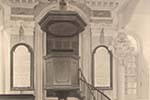
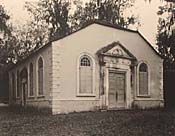
An Early Episcopal Church
St. James Church, built in South Carolina's oldest Anglican parish outside of Charleston, is
thought to have been constructed between 1711 and 1719 during the rectorate of the Reverend
Francis le Jau, a missionary of the Society for the Propagation of the Gospel in Foreign Parts.
St. James Church, Goose Creek, Berkeley County,
South Carolina, [exterior view] -
[interior view]
Photograph by Frances Benjamin
Johnston (1864-1952), c. 1930
Prints and Photographs Division,
Library of Congress (50-51)
|
Churches in eighteenth-century America came in all sizes and shapes, from the plain, modest
buildings in newly settled rural areas to elegant edifices in the prosperous cities on the eastern
seaboard. Churches reflected the customs and traditions as well as the wealth and social status
of the denominations that built them. Hence, a new Anglican Church in rural Goose Creek,
South Carolina, was fitted out with an impressive wood-carved pulpit, while a fledgling
Baptist Church in rural Virginia had only the bare essentials. German churches contained
features unknown in English ones.
|
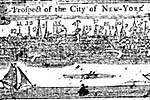
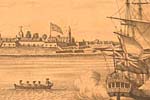
Growth of the Eighteenth-Century Church
The growth of the American church in the eighteenth century can be illustrated by changes in
city skylines over the course of the century. These three views of New York City in 1690,
1730, and 1771 display the increased number of the city's churches. An empty vista in 1690
had become a forest of eighteen steeples by 1771. Clearly discernable in the 1730 engraving
are (from left to right) the spires of Trinity Church (Anglican), the Lutheran Church, the
"new" Dutch Reformed Church, the French Protestant Church (Huguenots), City Hall, the
"old" Dutch Reformed Church, the Secretary's Office and the church in Fort George.
Nieuw Amsterdam on the island of Manhattan
Etching, c. 1690. Facsimile
>Geography & Map Division, Library of
Congress (47)
A View of Fort George with the City of New
York
Engraving by I. Carwithan, c. 1730
Geography & Map Division, Library of
Congress (48)
Prospect of the City of New York
Woodcut from Hugh Gaine, New York Almanac, 1771. Copyprint
The American Antiquarian Society, Worcester, Massachusetts (49)
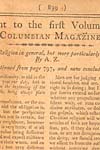
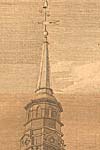 Christ Church, Philadelphia
Christ Church, Philadelphia
Christ Church of Philadelphia is an example of how colonial American congregations, once
they became well established and prosperous, built magnificent churches to glorify God.
Enlarged and remodelled, the Christ Church building was completed in 1744. A steeple was
added ten years later. Contemporaries were in awe of the finished house of worship, one
remarking that "it was the handsomest structure of the kind that I ever saw in any part of the
world; uniting in the peculiar features of that species of architecture, the most elegant variety
of forms, with the most chaste simplicity of combination."
A South East view of Christ's Church
Engraving in
Columbian Magazine, November 1787-
December 1787
Philadelphia: 1787
Rare Book and Special Collections Division,
Library of Congress (52)
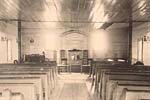
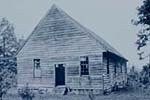 A Rural Baptist Church
A Rural Baptist Church
The South Quay Baptist Church (top) was founded in 1775, although it was not formally
"organized" until ten years later. The difference between the interior of the rural Mount
Shiloh Baptist Church and its Anglican counterpart, St. James Church, reveals much about the
differences between the denominations that worshiped in each structure.
Exterior of South Quay Baptist Church, Copyprint
Interior of Mt. Shiloh Baptist Church , Copyprint
Virginia Baptist Historical Society (53-54)
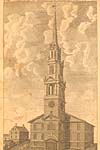 Colonial Baptist Church
Colonial Baptist Church
Believed to be the first Baptist church in America, the Providence congregation, founded by
Roger Williams, was organized in 1639. The meeting house, shown here, was constructed in
1774-1775 from plans by architect Joseph Brown, after a design by James Gibbs. This church
shows that some colonial Baptists had no compunctions about erecting imposing church
buildings.
A S.W. view of the Baptist Meeting House, Providence,
R.I.
Engraving by S. Hill for
Massachusetts Magazine
or Monthly
Museum of Knowledge and Rational Entertainment, August 1789
Rare Book and Special Collections Division,
Library of Congress (55)
 Lutheran Church Services
Lutheran Church Services
This view of the interior of a Lutheran Church by Pennsylvania folk artist Lewis Miller
(1796-1882) reveals features--wall paintings of great figures of the modern and early
church--which
would have been absent from English Protestant churches of the time. Notice the homey
interruptions to worship in early America such as the sexton chasing a dog out of the sanctuary
and a member stoking a stove.
">
In Side of the Old Lutheran Church in 1800, inYork, Pa.
Watercolor with pen and ink by Lewis Miller, c. 1800
The Historical Society of York County, Pennsylvania (56)
|

DEISM
|
"Deism" is a loosely used term that describes the views of certain English and continental
thinkers. These views attracted a following in Europe toward the latter part of the
seventeenth century and gained a small but influential number of adherents in America in the
late eighteenth century. Deism stressed morality and rejected the orthodox Christian view of
the divinity of Christ, often viewing him as nothing more than a "sublime" teacher of
morality. Thomas Jefferson and John Adams are usually considered the leading American
deists. There is no doubt that they subscribed to the deist credo that all religious claims were
to be subjected to the scrutiny of reason. "Call to her tribunal every fact, every opinion,"
Jefferson advised. Other founders of the American republic, including George Washington,
are frequently identified as deists, although the evidence supporting such judgments is often
thin. Deists in the United States never amounted to more than a small percentage of an
evangelical population.
|
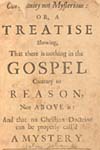 A Deist Tract
A Deist Tract
John Toland (1670-1722) was a leading English deist whose works, challenging the mysteries
at the heart of orthodox Christian belief, found an audience in the American colonies.
Christianity Not Mysterious: or, a Treatise shewing, That
there is nothing in the Gospel
Contrary to Reason, . . . .
John Toland
London: 1696
Rare Book and Special Collections
Division,
Library of Congress (59)
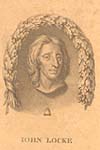
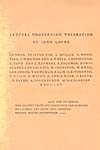 John Locke
John Locke
A famous political philosopher to whose views on the formation of governments most
Americans subscribed,
John Locke (1632-1704) wrote profoundly
important treatises on
religion. His letters on toleration became a bible to many in the eighteenth century, who were
still contending against the old theories of religious uniformity. Locke also argued for the
"reasonableness" of Christianity but rejected the efforts of Toland and other deists to claim
him as their spiritual mentor.
Letter Concerning Toleration
John Locke
London: A. Millar, H. Woodruff, et al., 1765
Rare Book and Special Collections
Division,
Library of Congress (57-58)
|

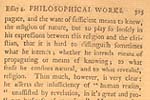 Bolingbroke's Influence on Thomas Jefferson
Bolingbroke's Influence on Thomas Jefferson
Lord Viscount Bolingbroke (1678-1751), an English deist, was a lifelong favorite of Jefferson.
In his Literary Commonplace Book, a volume compiled mostly in the 1760s, Jefferson copied
extracts from various authors, transcribing from Bolingbroke some 10,000 words, six times as
much as from any other author and forty percent of the whole volume. Young Jefferson was
particularly partial to Bolingbroke's observations on religion and morality.
The Philosophical Works of the late Right Honourable
Henry St. John,
Lord Viscount Bolingbroke [left page] -
[right
page]
Henry Saint-John, Viscount Bolingbroke, London: David Mallet, 1754
Rare Book and Special Collections Division,
Library of Congress (60)

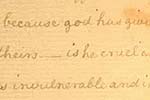 Thomas Jefferson's Literary Commonplace Book
Thomas Jefferson's Literary Commonplace Book
In this part of his Literary Commonplace Book, Thomas Jefferson copied from Bolingbroke's
Works, a passage unfavorably comparing New Testament ethics to those of the
"antient heathen moralists of Tully, of Seneca, of Epictetus [which] would be more full, more
entire, more coherent, and more clearly deduced from unquestionable principles of
knowledge."
Literary Commonplace Book [left page] -
[right page]
Thomas Jefferson, Holograph Manuscript
Manuscript Division, Library of Congress
(61)
|

THE EMERGENCE OF AMERICAN
EVANGELICALISM:
THE GREAT AWAKENING
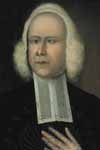 George Whitefield
George Whitefield
One of the great evangelists of all time, George Whitefield (1714-1770) was ordained in the
Church of England, with which he was constantly at odds. Whitefield became a sensation
throughout England, preaching to huge audiences. In 1738 he made the first of seven visits to
the America, where he gained such popular stature that he was compared to George
Washington. Whitefield's preaching tour of the colonies, from 1739 to 1741,
was the high-water mark of the Great Awakening there. A sermon in Boston
attracted as many as 30,000
people. Whitefield's success has been attributed to his resonant voice, theatrical presentation,
emotional stimulation, message simplification and clever exploitation of emerging advertising
techniques. Some have compared him to modern televangelists.
George Whitefield
Oil on canvas,
attributed to Joseph Badger (1708-1765), c. 1743-65,
Harvard University Portrait Collection,
Gift of Mrs. H.P. (Sarah O.) Oliver
to Harvard College, 1852 (62)
 Preaching in the Field
Preaching in the Field
George Whitefield used this collapsible field pulpit for open-air preaching because the doors of
many churches were closed to him. The first recorded use of the pulpit was at Moorsfield,
England, April 9, 1742, where Whitefield preached to a crowd estimated at "twenty or thirty
thousand people." Members of the audience who had come to the park for more frivolous
pursuits showered the evangelist with "stones, rotten eggs and pieces of dead cat" Nothing
daunted, and he won many converts. It is estimated that Whitefield preached two thousand
sermons from his field pulpit.
Portable field pulpit
Oak, c. 1742-1770
American Tract Society,
Garland, Texas (63)
|
Evangelicalism is difficult to date and to define. In 1531, at the beginning of the Reformation,
Sir Thomas More referred to religious adversaries as "Evaungelicalles." Scholars have argued
that, as a self-conscious movement, evangelicalism did not arise until the mid-seventeenth
century, perhaps not until the Great Awakening itself. The fundamental premise of
evangelicalism is the conversion of individuals from a state of sin to a "new birth" through
preaching of the Word.
The first generation of New England Puritans required that church members undergo a
conversion experience that they could describe publicly. Their successors were not as
successful in reaping harvests of redeemed souls. During the first decades of the eighteenth
century in the Connecticut River Valley a series of local "awakenings" began. By the 1730s
they had spread into what was interpreted as a general outpouring of the Spirit that bathed the
American colonies, England, Wales, and Scotland. In mass open-air revivals powerful
preachers like George Whitefield brought thousands of souls to the new birth. The Great
Awakening, which had spent its force in New England by the mid-1740s, split the
Congregational and Presbyterian Churches into supporters--called "New Lights" and "New
Side"--and opponents--the "Old Lights" and "Old Side." Many New England New Lights
became Separate Baptists. Together with New Side Presbyterians (eventually reunited on their
own terms with the Old Side) they carried the Great Awakening into the southern colonies,
igniting a series of the revivals that lasted well into the nineteenth century.
|
 Whitefield on the New Birth
Whitefield on the New Birth
The "new birth," prescribed by Christ for Nicodemus (John 3:1-8), was the term
evangelicalism used for the conversion experience. For George Whitefield and other
evangelical preachers the new birth was essential to Christian life, even though, as Whitefield
admitted, "how this glorious Change is wrought in the Soul cannot easily be explained."
The Marks of the New Birth. A Sermon. . .
.
George Whitefield
New York: William Bradford, 1739
Rare Book and Special Collections
Division,
Library of Congress (64)

The Reverend Mr. George Whitefield A.M.
Mezzotint by John Greenwood, after Nathaniel Hone, 1769. Copyprint.
National Portrait Gallery, Smithsonian Institution. (65)
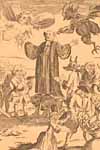 Whitefield Satirized
Whitefield Satirized
George Whitefield acquired many enemies, who assailed evangelicalism as a distortion of the
gospel and attacked him and his followers for alleged moral failings. The evangelist endured
many jibes at his eye disease; hence the epithet "Dr. Squintum." This satire shows an imp
pouring inspiration in Whitefield's ear while a grotesque Fame, listening on the other side
through an ear trumpet, makes accusations on two counts that have dogged revivalists to the
present day: sex and avarice. The Devil, raking in money below the podium, and the caption
raise charges that Whitefield was enriching himself by his ministry. At the lower left,
Whitefield's followers proposition a prostitute, reflecting the line in the caption that "their
Hearts to lewd Whoring extend."
Dr. Squintum's Exaltation or the Reformation
Engraving, London: 1763
Prints and Photographs Division, Library of Congress
(66)
 Whitefield's Death
Whitefield's Death
Whitefield's death and burial at Newburyport, Massachusetts, in 1770 made a deep impression
on Americans from all walks of life. Among the eulogies composed for Whitefield was one
from an unexpected source: a poem by a seventeen-year-old Boston slave, Phillis Wheatley
(ca. 1753-1784), who had only been in the colonies for nine years. Freed by her owners,
Phillis Wheatley continued her literary career and was acclaimed as the "African poetess."
George Whitefield's Burial
Woodcut from Phillis [Wheatley], An Elegiac Poem on the Death
of that celebrated Divine
and eminent Servant of Jesus Christ, the Reverend and learned
George Whitefield
Boston: Ezekiel Russell, 1770
Rare Book and Special Collections Division,
Library of Congress (67)
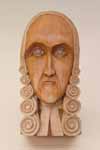 Jonathan Edwards
Jonathan Edwards
Jonathan Edwards (1703-17) was the most important American preacher during the Great
Awakening. A revival in his church in Northampton, Massachusetts, 1734-1735, was
considered a harbinger of the Awakening which unfolded a few years later. Edwards was
more than an effective evangelical preacher, however. He was the principal intellectual
interpreter of, and apologist for, the Awakening. He wrote analytical descriptions of the
revival, placing it in a larger theological context. Edwards was a world-class theologian,
writing some of the most original and important treatises ever produced by an American. He
died of smallpox in 1758, shortly after becoming president of Princeton.
Jonathan Edwards
White pine tinted with oils, C. Keith Wilbur, M.D., 1982
Courtesy of the artist (68)
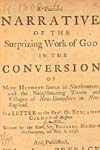 The Revival of Northampton
The Revival of Northampton
Jonathan Edwards's( account of a revival in his own church at Northampton, Massachusetts,
and in neighboring churches in the Connecticut Valley was considered a portent of major
spiritual developments throughout the British Empire. Consequently, his Narrative was first
published in London in 1737 with an introduction by two leading English evangelical
ministers, Isaac Watts, the famous hymnist, and John Guyse. In their introduction the two
divines said that "never did we hear or read, since the first Ages of Christianity, any Event of
this Kind so surprising as the present Narrative hath set before us."
A Faithful Narrative of the Surprising Work of God in
the Conversion of Many Hundred Souls
Jonathan Edwards, London: John Oswald, 1737
Rare Book and Special Collections Division,
Library of Congress (69)
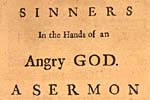 Sinners Warned
Sinners Warned
Perhaps Jonathan Edward's only writing familiar to most modern audiences, Sinners in the
Hands of an Angry God was not representative of his vast theological output, which contains
some of the most learned and profound religious works ever written by an American. Like
most evangelical preachers during the Great Awakening, Edwards employed the fear of divine
punishment to bring his audiences to repentance. However, it is a distortion of his and his
colleagues' messages and characters to dismiss them as mere "hellfire" preachers.
Sinners in the Hands of an Angry God
Jonathan Edwards, Boston: 1741
Rare Books Division, The New York Public Library, Astor, Lenox and Tilden Foundations
(70)
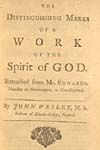 Trans-Atlantic Evangelicalism
Trans-Atlantic Evangelicalism
The publication by John Wesley, the founder of Methodism, of extracts from Jonathan
Edwards's Distinguishing Marks of a Work of the Spirit of God illustrates the
trans-Atlantic
character of the Great Awakening. The leaders communicated with each other, profited from
each others' publications and were in some cases personal acquaintances.
The Distinguishing Marks of a Work of the Spirit of
God. Extracted from Mr. Edwards
John Wesley, London: William Strahan, 1744
Rare Book and Special Collections Division,
Library of Congress (71)
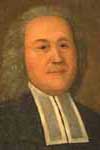 Gilbert Tennent
Gilbert Tennent
Gilbert Tennent (1703-1764) was the Presbyterian leader of the Great Awakening in the
Middle Colonies. Upon George Whitefield's departure from the colonies in 1741, he
deputized his friend Tennent to come from New Jersey to New England to "blow up the divine
fire lately kindled there." Despite being ridiculed as "an awkward and ridiculous Ape of
Whitefield," Tennent managed to keep the revival going until 1742.
Gilbert Tennent
Oil on canvas, attributed to Gustavus Hesselius (1682-1755)
Princeton University (72)
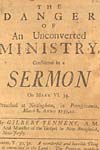 Criticism of Other Ministers
Criticism of Other Ministers
This famous sermon, which Gilbert Tennent preached at Nottingham, Pennsylvania, in 1740,
was characteristic of the polemics in which both the friends and enemies of the Great
Awakening indulged. Tennent lashed ministerial opponents who had reservations about the
theology of the new birth as "Pharisee-Shepherds" who "with the Craft of Foxes . . . did not
forget to breathe the Cruelty of Wolves in a malicious Aspersing of the Person of Christ."
The Danger of an Unconverted Ministry
Gilbert Tennent, A.M.
Philadelphia: Benjamin Franklin, 1740
Rare Book and Special Collections Division,
Library of Congress (73)
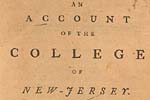
 Fundraising for Princeton
Fundraising for Princeton
From the Great Awakening onward, evangelical Christians have founded colleges to train a
ministry to deliver their message. The College of New Jersey (later Princeton University) was
founded in 1746 by New Side Presbyterian sympathizers. This fundraising brochure for the
infant college was prepared in 1764 by the New Side stalwart, Samuel Blair. "Aula
Nassovica," the Latinized version of Nassau Hall, was the principal building of the College of
New Jersey in 1764.
An Account of the College of New Jersey [left
page] -
[right page]
Samuel Blair
Woodbridge, New Jersey: James Parker, 1764
Rare Book and Special Collections Division,
Library of Congress (74)
 Samuel Davies
Samuel Davies
Samuel Davies (1723-1761) was the spearhead of the efforts of New Side Presbyterians to
evangelize Virginia and the South. Establishing himself in Hanover County, Virginia, in the
1740s, Davies was so successful in converting members of the Church of England to the new
birth that he was soon embroiled in disputes with local officials about his right to preach the
gospel where he chose.
Samuel Davies
Oil on canvas
Union Theological Seminary and
Presbyterian School of Christian Education, Richmond,
Virginia (75)
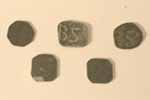 Presbyterian Communion Tokens
Presbyterian Communion Tokens
The sacrament of Holy Communion was precious to colonial Presbyterians (and to members of
other Christian churches). Presbyterians followed the Church of Scotland practice of "fencing
the table"--of permitting members to take communion only after being examined by a minister
who vouched for their spiritual soundness by issuing them a token that admitted them to the
celebration of the sacrament. The custom continued in some Presbyterian churches until early
in this century. The tokens shown here were used in the Beersheba Presbyterian Church, near
York, South Carolina.
Presbyterian communion tokens
Metal, c.1800
Courtesy of Martha Hopkins and Nancy Hopkins-Garriss (76)
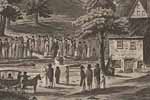
View on Jones's Falls, Baltimore, Sept. 13,
1818
Engraving and watercolor on paper by J. Hill
Robert C. Merrick Print Collection, Prints and Photographs Department,
Maryland Historical Society Library, Baltimore. (77a)
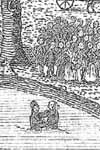 The Baptists
The Baptists
Although Baptists had existed in the American colonies since the seventeenth century, it was
the Great Awakening that galvanized them into a powerful, proselytizing force. Along with
the Methodists, the Baptists became by the early years of the nineteenth century the principal
Protestant denomination in the southern and western United States. Baptists differed from
other Protestant groups by offering baptism (by immersion) only to those who had undergone a
conversion experience; infants were, therefore, excluded from the sacrament, an issue that
generated enormous controversy with other Christians.
Baptism in Schuylkill River
Woodcut from Morgan Edwards, Materials Towards A History of the American
Baptists.
Copyprint, Philadelphia: 1770
Historical Society of Pennsylvania (77b)
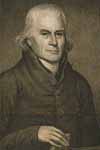 Francis Asbury
Francis Asbury
Methodism, begun by John Wesley and others as a reform movement within the Church of
England, spread to the American colonies in the 1760s. Although handicapped by Wesley's
opposition to the American Revolution, Methodists nevertheless made remarkable progress in
the young American republic. Francis Asbury (1745-1816) was the dynamo who drove the
spectacular growth of the church. He ordained 4,000 ministers, preached 16,000 sermons and
traveled 270,000 miles on horseback, sometimes to the most inaccessible parts of the United
States.
Francis Asbury
Oil on canvas by Charles Peale Polk, 1794
Lovely Lane Museum of United Methodist Historical Society, Baltimore (78)
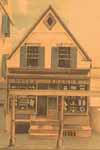 Beginning of the Methodists
Beginning of the Methodists
The first Methodist meeting in New York City (one of the first in the American colonies) was
held in the sail loft of this Manhattan rigging house in 1766. The five people who attended
helped launch the Methodist Church on a "prosperous voyage" that by 1846, according to the
statistics furnished in the caption, had gathered four million members.
The Rigging House
Color lithograph by A. R. Robinson, 1846
Prints and Photographs Division, Library of
Congress (79)
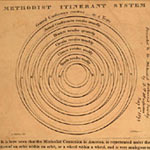 Organization
of the Methodists Organization
of the Methodists
The remarkable growth of the Methodists in the post-Revolutionary period has been attributed
to a hierarchical organizational structure that permitted the maximum mobilization of
resources. The "corporating genius" of the Methodists is depicted in this series of concentric
circles.
Methodist Itinerant System
G. Stebbins and G. King, Broadside
New York: John Totten, 1810-11 [?]
Rare Books Division, The New York Public Library, Astor, Lenox and Tilden Foundations
(80)
|
 HOME -
EXHIBITION OVERVIEW
HOME -
EXHIBITION OVERVIEW
SECTIONS:
I. America as Refuge -
II. 18th Century America
III. American Revolution -
IV. Congress of the Confederation -
V. State Governments
VI. Federal Government -
VII. New Republic

|






 Christ Church, Philadelphia
Christ Church, Philadelphia
 A Rural Baptist Church
A Rural Baptist Church Colonial Baptist Church
Colonial Baptist Church Lutheran Church Services
Lutheran Church Services A Deist Tract
A Deist Tract
 John Locke
John Locke
 Bolingbroke's Influence on Thomas Jefferson
Bolingbroke's Influence on Thomas Jefferson
 Thomas Jefferson's Literary Commonplace Book
Thomas Jefferson's Literary Commonplace Book George Whitefield
George Whitefield Preaching in the Field
Preaching in the Field Whitefield on the New Birth
Whitefield on the New Birth
 Whitefield Satirized
Whitefield Satirized Whitefield's Death
Whitefield's Death Jonathan Edwards
Jonathan Edwards The Revival of Northampton
The Revival of Northampton Sinners Warned
Sinners Warned Trans-Atlantic Evangelicalism
Trans-Atlantic Evangelicalism Gilbert Tennent
Gilbert Tennent Criticism of Other Ministers
Criticism of Other Ministers
 Fundraising for Princeton
Fundraising for Princeton Samuel Davies
Samuel Davies Presbyterian Communion Tokens
Presbyterian Communion Tokens
 The Baptists
The Baptists Francis Asbury
Francis Asbury Beginning of the Methodists
Beginning of the Methodists Organization
of the Methodists
Organization
of the Methodists